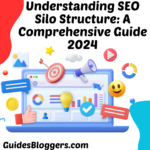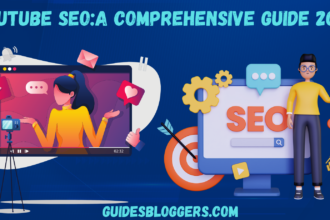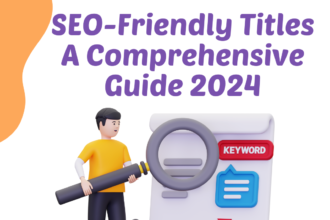Search Engine Optimization (SEO) is the process of improving a website’s visibility on search engines like Google, Bing, and Yahoo. When done correctly, SEO can help your website rank higher in search engine results pages (SERPs), driving more organic (non-paid) traffic to your site. In this tutorial, we’ll explore the basics of SEO, explain how it works, and provide actionable steps to get you started.
Check : SEO-Friendly Titles: A Comprehensive Guide 2024
1. Understanding How Search Engines Work
Before diving into SEO, it’s essential to understand how search engines work. Search engines like Google use complex algorithms to index and rank web pages based on various factors, including relevance, quality, and user experience.
- Crawling: Search engines use bots (often called “spiders” or “crawlers”) to discover new and updated content on the web. These bots follow links from one page to another, indexing the content they find along the way.
- Indexing: Once a page is crawled, the search engine stores and organizes the information in its database (index). The index contains a massive collection of web pages that the search engine can pull from when a user performs a search query.
- Ranking: When a user enters a search query, the search engine’s algorithm determines which pages are most relevant and displays them in the SERPs. Pages are ranked based on factors such as keyword relevance, content quality, user experience, and backlinks.
2. Keyword Research: The Foundation of SEO
Keyword research is the process of identifying the terms and phrases your target audience uses when searching for products, services, or information related to your website. Effective keyword research is crucial because it helps you understand what your audience is looking for and how to optimize your content to meet their needs.
- Identifying Seed Keywords: Start by brainstorming a list of seed keywords—broad terms related to your industry or niche. For example, if you run a fitness blog, seed keywords might include “workout routines,” “healthy eating,” or “weight loss tips.”
- Using Keyword Research Tools: Tools like Google Keyword Planner, Ahrefs, SEMrush, and Ubersuggest can help you find related keywords, search volume, and competition level. Look for keywords with a high search volume but moderate to low competition.
- Long-Tail Keywords: Long-tail keywords are longer, more specific phrases that often have lower search volume but higher conversion rates. For example, “best workout routines for beginners” is a long-tail keyword. These are valuable because they target a more specific audience.
3. On-Page SEO: Optimizing Your Content
On-page SEO refers to the practice of optimizing individual web pages to rank higher and earn more relevant traffic. Here are some key elements of on-page SEO:
- Title Tags: The title tag is the HTML element that specifies the title of a web page. It’s one of the first things search engines and users see, so it should include your target keyword and be both descriptive and enticing. Aim for 50-60 characters.
- Meta Descriptions: The meta description is a brief summary of a page’s content that appears under the title in SERPs. It should be 150-160 characters long and include your primary keyword. Although it doesn’t directly impact rankings, a compelling meta description can improve click-through rates (CTR).
- Header Tags (H1, H2, H3, etc.): Header tags help organize your content and make it easier for both users and search engines to understand. The H1 tag should include your primary keyword and serve as the main headline, while H2 and H3 tags can be used for subheadings.
- Keyword Usage: Naturally incorporate your target keywords throughout your content, including in the first 100 words, in headers, and in alt text for images. However, avoid keyword stuffing, as it can negatively impact user experience and rankings.
- Internal Linking: Linking to other pages on your website helps search engines understand the structure of your site and can improve the ranking of your pages. It also keeps users engaged by guiding them to related content.
- Image Optimization: Use descriptive file names and alt text for images. Compress images to reduce file size and improve page load speed, which is an important ranking factor.
4. Technical SEO: Enhancing Your Website’s Performance
Technical SEO focuses on optimizing the backend structure and performance of your website to help search engines crawl and index your content more effectively.
- Mobile-Friendliness: With more than half of all web traffic coming from mobile devices, having a mobile-friendly website is crucial. Use responsive design to ensure your site looks and functions well on all screen sizes.
- Page Speed: Fast-loading pages provide a better user experience and are favored by search engines. Use tools like Google PageSpeed Insights to identify and fix issues that may be slowing down your site, such as unoptimized images, excessive JavaScript, or server issues.
- XML Sitemaps: An XML sitemap is a file that lists all the pages on your website, helping search engines find and index them. Most content management systems (CMS) like WordPress can automatically generate an XML sitemap for you.
- Robots.txt File: This file tells search engines which pages or sections of your site should not be crawled. It’s essential to ensure that your robots.txt file doesn’t accidentally block important pages from being indexed.
- SSL Certificates: An SSL certificate encrypts data between your website and its users, providing a secure browsing experience. Google prioritizes HTTPS websites in its rankings, so having an SSL certificate is a must.
5. Off-Page SEO: Building Authority and Trust
Off-page SEO involves activities outside of your website that influence your rankings. The primary focus of off-page SEO is building high-quality backlinks from reputable websites.
- Backlinks: Backlinks, or inbound links, are links from other websites that point to your site. Search engines view backlinks as a vote of confidence in your content, and the more high-quality backlinks you have, the better your site will rank.
- Guest Blogging: Writing guest posts for reputable blogs in your industry can help you build backlinks and increase your exposure to a new audience.
- Social Media Engagement: While social media signals are not a direct ranking factor, promoting your content on social platforms can drive traffic to your site and increase the likelihood of earning backlinks.
- Online Directories: Submitting your website to online directories like Yelp, Google My Business, and industry-specific directories can help improve your local SEO and increase your online presence.
6. Content Marketing: The Heart of SEO
High-quality, relevant content is the foundation of SEO. Content marketing involves creating and sharing valuable content that attracts and engages your target audience. This not only helps you rank for your target keywords but also builds trust and authority in your niche.
- Blogging: Regularly publishing blog posts on topics related to your industry is an effective way to target long-tail keywords and provide value to your audience. Make sure your content is well-researched, informative, and optimized for SEO.
- Video Content: Video content is increasingly popular and can be a great way to engage your audience. Platforms like YouTube are also search engines, so optimizing your video titles, descriptions, and tags can help your content get discovered.
- Infographics: Infographics are visually appealing and can simplify complex information, making them highly shareable. Including infographics in your content strategy can drive traffic and earn backlinks.
- Content Updates: Search engines favor fresh content, so regularly updating your existing content can help maintain and improve your rankings. Revisit old blog posts, update statistics, and add new information to keep your content relevant.
7. Analytics and Monitoring: Measuring Success
To determine whether your SEO efforts are paying off, you need to track your progress and make data-driven decisions.
- Google Analytics: Google Analytics is a free tool that provides insights into your website’s traffic, user behavior, and conversion rates. Use it to track which pages are performing well, where your traffic is coming from, and how users are interacting with your content.
- Google Search Console: Google Search Console helps you monitor your website’s presence in Google’s search results. It provides information on which queries are driving traffic to your site, any indexing issues, and how your site is performing in the SERPs.
- Keyword Rankings: Use tools like Ahrefs, SEMrush, or Moz to track your keyword rankings over time. Monitoring your rankings can help you identify which keywords are performing well and which ones may need more attention.
- Backlink Analysis: Regularly review your backlink profile to ensure that you’re earning high-quality backlinks. Tools like Ahrefs and Moz can help you identify new backlinks, monitor their quality, and disavow any toxic links that could harm your rankings.
Conclusion
SEO is a long-term strategy that requires patience, persistence, and continuous learning. By understanding the basics of how search engines work and implementing the techniques outlined in this tutorial, you’ll be well on your way to improving your website’s visibility and driving organic traffic. Remember, SEO is not a one-time task but an ongoing process that involves regularly updating your content, building quality backlinks, and optimizing your website for both search engines and users.










